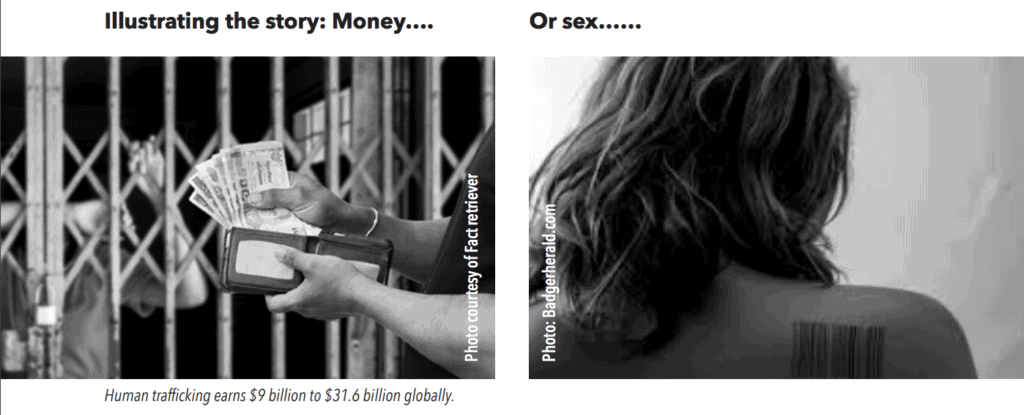Media and Trafficking in Human Beings Guidelines was authored by the Ethical Journalism Network as part of a project funded by the European Union and implemented by an international consortium led by the International Centre for Migration Policy Development (ICMPD). © 2017. Republished with permission.
GOOD PRACTICE: GUIDELINES FOR PHOTO-JOURNALISM
Every journalist wants interviews, photos and video of people currently in some form of enslavement or forced labour. The drama and tragedy of migrant deaths, often involving people who are caught up in trafficking has been a rich source of powerful images,but many of them controversial.
Remember that bringing a news crew into a situation where there are vulnerable,terrified and exploited people can be traumatic. Journalists should do everything they can to create a safe and reassuring atmosphere when they are filming people who have been the victims of trafficking.
Journalism is strengthened by the use of powerful images in story-telling but it’s vital that media are careful to avoid providing superficial impressions that reinforce stereotypes.
Avoid use of pictures or creating video images that pander to sensationalism, intrusion and voyeurism.
Always ask permission to film and to take pictures of individuals, although this should not be necessary in a public setting. Seek written permission in advance if possible.
Avoid using sexualised images and avoid pictures that reflect a cliché — a girl in chains or a person with a barcode on them, or a child behind bars or in a seedy brothel. These contribute to stereotypes about trafficking that can be misleading. For instance, many victims of trafficking are people who have survived and are recovering. Many were not brutally forced into exploitation but were manipulated emotionally and became dependent.
Avoid explicit images of violence. It is very rarely that images of extreme violence need to be shown in the public interest.In general, editors and film-makers need to consider how much use of images of bodily harm is acceptable?Where do we draw the line? Is it justified to show the scars, bruises, broken limbs of victims of slavery and trafficking in order to tell the story?
Good journalism will raise awareness of anti-trafficking through images and messages that empower rather than simplify and further exploit the victims and survivors of trafficking.

Photo courtesy of Fact retriever Photo: Badgerherald.com
How does a picture of a faceless human with a barcode on them help humanize the situation of survivors of human trafficking?
Sex is what turns media on
Forced labour, trafficking, and modern slavery are core issues, but it’s the issue of sex that too often dominates media headlines. A detailed analysis of almost 3000 reports in British media found that human trafficking stories with a sex angle were more likely to get coverage than issues related to forced labour or modern slavery according to a report by the Joseph Rowntree Foundation in 2013. This reporting can be a gateway to wider discussion of the issue, but the research showed a dramatic under-reporting of the far bigger problem of modern slavery.
Migration How Politics Distorts Media Coverage
Negative voices over immigration seems to grab media attention more than reporting on trafficking, even when it is on your own doorstep.The country reports produced by the Ethical Journalism Network and the International Centre for Migration Policy Development in 20159 and in201610 contained clear evidence that undue political influence on media coverage, often based upon false or distorted information, crowded outfocus on deeper problems such as forced labour, child labour and trafficking. The challenge to media and journalism is to devote appropriate space to the very real issues of immigration and at the same expose and report on human rights abuse that is perpetrated in the clear light of day.